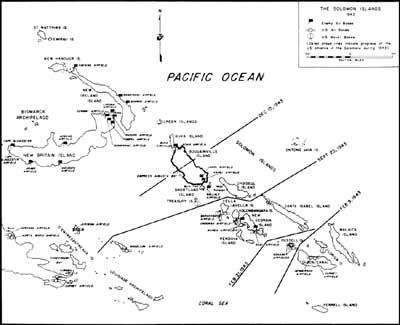|
TIME OF THE ACES: Marine Pilots in the Solomons
by Commander Peter B. Mersky, U.S. Naval Reserve
The morale of the men of the 1st Marine Division on
Guadalcanal soared dramatically in the late afternoon of 20 August 1942.
That was when 19 Grumann F4F Wildcats of Captain John L. Smith's Marine
Fighter Squadron (VMF) 223 and 12 Douglas Dauntless SBDs of Major
Richard C. Mangrum's Marine Scout-Bomber Squadron (VMSB) 232 landed on
yet-uncompleted Henderson Field. Ever since the assault landing on
Guadalcanal on 7 August, and subject to unchallenged Japanese air raids
from that time, the ground troops wondered, "Where are our planes?" Like
so many other soldiers in so many other campaigns, they had little
knowledge of the progress of the war elsewhere in the Pacific.

|
|
"Fogerty's Fate — 22 Oct 1942." TSgt John Fogerty,
an enlisted Marine pilot, was killed this date. Watercolor by Col
Albert M. Leahy, USMCR (Ret), in the Marine Corps Art
Collection.
|
From the very beginning of World War II, with the
Japanese attack on Wake Island, Marine aircraft, pilots, and crews
became immediately and personally involved in the fighting. On Wake,
Marine Wildcat pilots of VMF-211 gave a good account of themselves, even
after the number of the squadron's flyable planes was reduced to four,
and when those planes were damaged beyond repair, all aviation personnel
became riflemen. And in the Battle of Midway, Marine pilots for the
first time at first hand apprehended the nature of the war in the air as
they flew against combat-experienced Japanese aircrews. But by the time
of the landings on Guadalcanal and when the war was nearly a year old,
only a relatively small number of Marine pilots had seen combat. A few
had shot down several Japanese aircraft, although none had scored a
fifth kill which would entitle him to be designated an ace. The leading
Marine scorer at Midway was Captain Marion Carl, who had downed two
Mitsubishi Type "O" Carrier Fighters. The Americans would later call
them "Zeros" or "Zekes" and would shoot them down regularly despite the
early reputation they received for being a highly maneuverable and
deadly adversary in the air. Before he left the Pacific, Captain Carl
would add considerably to his score, as would some of the other fighter
pilots who landed on Guadalcanal with him on the 20th.

(click on image for an enlargement in a new window)
|
|




